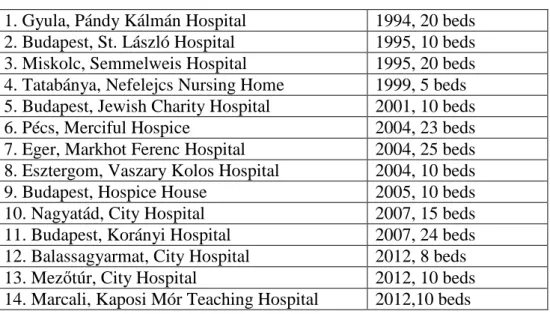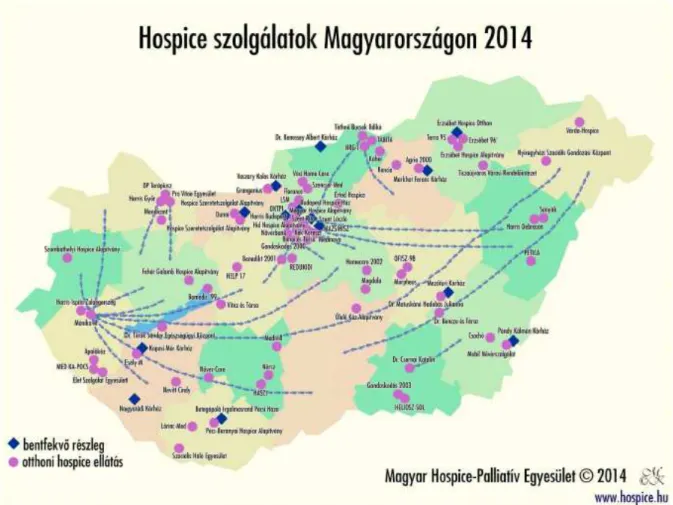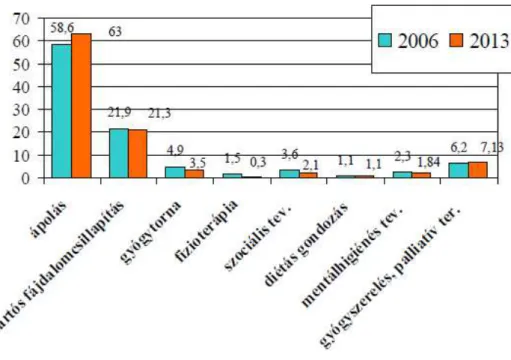Hospice Patient Care 2013 -
A Hungarian Hospice-Palliative Association Assessment Compiled by:
Dr. Katalin Hegedűs and Katalin Munk Hungarian Hospice-Palliative Association
www.hospice.hu
According to the Hungarian Hospice-Palliative Association’s (HHPA / MHPE in Hungarian) statistical survey 87 patient care facilities as well as home services provided hospice care in 2013:
- 14 hospice inpatient units (200 beds); - 64 hospice home care teams;
- 4 hospice mobile teams (hospital supporting teams); and - 3 palliative outpatient services.
Two children’s hospice also operate: the Tábitha Ház (Tabitha House) in Törökbálint with 5 beds and the Dóri Ház (Dori House) in Pécs with 2 beds, but the National Health Insurance Fund (NHIF / OEP in Hungarian)—although they recognize the activities—does not finance them. The permit for each house allows hospice and relief-care in the patient’s home or at the temporary accommodation. They maintain their operations from foundation and other
support, and from donations (see http://www.hospice.hu/hospice-ok/ for the hospice providers).
Institutional care provided 200 beds altogether. The WHO recommends a minimum of 50 palliative beds for a population of 1 million, which means 500 beds in the case of a 10 million population1. Compared to this Hungary is very much lagging, even compared to neighbouring countries. (In Slovakia, for example, there are 277 hospice beds for a population of less than 5 million.2) The causes continue to be those mentioned in previous reports: hospitals do not have a great interest in setting up hospices; they do not realise the importance, they consider it an added cost and they do not readily assume the prescribed minimum conditions for training of healthcare specialists. (See Table 1 for a list of institutional hospices.)
Table 1: Institutional hospices (city, name) with year of establishment and number of beds 1. Gyula, Pándy Kálmán Hospital 1994, 20 beds 2. Budapest, St. László Hospital 1995, 10 beds 3. Miskolc, Semmelweis Hospital 1995, 20 beds 4. Tatabánya, Nefelejcs Nursing Home 1999, 5 beds 5. Budapest, Jewish Charity Hospital 2001, 10 beds
6. Pécs, Merciful Hospice 2004, 23 beds
7. Eger, Markhot Ferenc Hospital 2004, 25 beds 8. Esztergom, Vaszary Kolos Hospital 2004, 10 beds
9. Budapest, Hospice House 2005, 10 beds
10. Nagyatád, City Hospital 2007, 15 beds
11. Budapest, Korányi Hospital 2007, 24 beds 12. Balassagyarmat, City Hospital 2012, 8 beds 13. Mezőtúr, City Hospital 2012, 10 beds 14. Marcali, Kaposi Mór Teaching Hospital 2012,10 beds
The increase in the number of hospice care providers continues to be due to, primarily, the increase in home services—characteristically providers initiating services in more than one county. (See Figure 1.)
Figure 1: Hospice service providers in Hungary, 2014
bentfekvő részleg = inpatient unit; otthoni hospice ellátás = home hospice care
Financing from the NHIF was the following:
1. for institutional inpatient units, based on annex 8 to government financing decree number 43/1999. (III.3.) under the heading of chronic care, as special rehabilitation care with a multiplier of 1.7. Thus: 5600 x 1.7 = 9520 Forints.
2 in the case of home hospice care, paragraph 35 of government decree number 43/1999 prescribed a 1.2 multiplier of the home specialised nursing base fee for a maximum period of 50 days; which under defined conditions can be extended twice—in accordance with a specialist physician’s recommendation. Thus, a total of 150 funded days may be available for each patient. The home hospice daily support increased in January 2013 from 3820 Forints to 4060 Forints.
The NHIF appropriated 780 million Forints for hospice care, which was distributed among the counties according to the number of inhabitants. (Of the total, somewhat more than 600 million Forints was paid out.3)
In 2013 the number of patients receiving hospice care was 7862 according to the 76 organisations providing data. This is barely more than 22 % of the 32,670 cancer deaths in Hungary. Of that number of hospice patients, 97.3 % were cancer patients; the average length of care was 34 days, the bed occupancy rate in hospital inpatient departments was 79 %, the mortality rate was 65 % and the percentage of deaths occurring at home was 37.9 %.
The distribution of home hospice services was the following: nursing: 63 %; long-term pain management: 21.3 %; physical therapy: 3.5 %; physiotherapy: 0.3 %; social activities: 2.1 %; dietary care: 1.1 %; mental health care and advice: 1.84 %; medication and palliative therapy: 7.13 %. As can be seen in the figure below, since the beginnings of home hospice care
financing, medication and palliative therapy—that is, the palliative medical activities—are low—less than 10 %—while at the same time the activities that reflect true team work: mental health, social, physiotherapy treatments or dietary care also constitute only a small
percentage. (See Figure 2.)
Figure 2: The percentage distribution of home hospice activities, 2006-20134
Among the causes to be mentioned are lack of funding and problems with attitudes; see the listing below of the major difficulties.
The changes in availability of personnel nationwide are shown in Table 2.
Table 2: Hospice personnel, 2012 and 2013
Personnel in 20125 Personnel in 20136 Physicians 145 145 Nurses 700 743 Physiotherapists 151 169 Psychologist/Mental hygienists 83 88 Volunteers 222 153
Clergy 28 36 Social workers 59 65 Dieticians 62 68 Administrators/Coordinators 72 84 Occupational therapists 6 4 Bereavement counsellors 13 9 Totals: 1541 1562
From the data we can see that—although the number of hospice services is increasing—the number of physicians, nurses and other professionals does not grow proportionately; in fact, if we compare with earlier surveys, then the number is clearly decreasing. This means that, unfortunately, the work-load is increasing, which could lead to earlier burn-out in those positions.
The ministerial decree regarding the minimum standards for hospice (decree 60/2003 of the Ministry of Health, Social and Family Affairs (ESzCsM in Hungarian) as modified by decree 1/2012 (V.31.) of the Ministry of Human Capacities (EMMI in Hungarian)) prescribes the existence of a multidisciplinary team, as well as completion of training for every hospice staff member. According to the data providers the majority of professionals working in hospice (on average 70 to 80 %) completed hospice training or further education in palliative care. The National Public Health and Medical Officer Service (ANTSZ in Hungarian) checks on the qualification, and the staff member’s training certification makes-up an annex to the NHIF contract. In 2013—on a national level—some 1600 professionals and volunteers took part in a variety of hospice and palliative trainings.
Two important ministerial decrees regarding continuing education of physicians were issued recently: Ministry of Human Capacities decree number 22/2012 (IX.14.) on required courses for resident physician training and decree number 23/2012 (IX.14.) on specialist licensing. Since 2013 in every medical university every resident must take part in a 40 hour palliative training as part of their compulsory continuing education! The opportunity to obtain a
palliative specialist licence came into being from autumn of 2014 with the decree on specialist licensing. Both of these will hopefully improve the attitude and awareness of physicians, which may affect the development of true team-work.
When considering the operational funding for hospice—including the enhanced multiplier— NHIF support covers only 70-80 % of that needed for true quality hospice care: 75 % of inpatient care units and 80 % of home hospice cost is funded. This is why it is necessary to search for supplementary sources. Among the data providers 28 hospice patient care providers responded that beyond the NHIF or social funding other sources were also used—in most cases several. 16 organisations reported that they receive donations from corporations or private individuals, 12 receive support from a variety of foundations, 16 benefit from the personal income tax 1 % gifting, and 6 providers received TÁMOP (Social Renewal Operational Programme), NEA (National Civil Fund) or other grant support. In 2011, for example, 14 organisations won support—this indicates, unfortunately, a tightening of the opportunities for such grants.
The main difficulties highlighted by the organisations fall into the following problem categories (the number of instances is in parenthesis):
Inappropriate attitude (76)
1. Late arrival of patients into hospice (32)
2. Lack of knowledge and cooperation (mainly among family doctors) (20) 3. Attitude problems (17)
4. Uncertainties regarding patient transfer (e.g., terminal stage) (7) Financial problems (41)
5. Financial difficulties, under financed (34) 6. Finding other sources (6)
7. Problems with the national and county health insurance services—OEP and MEP (documentation, reduction/withdrawal of financing) (1)
Other, infrastructure problems (17)
8. Shortage of physicians and other professionals (physiotherapists, psychologists) (9) 9. Infrastructure problems (6)
10. Socially disadvantaged families (2)
The main problem categories remain the same since 2010: financial difficulties, late arrival of patients into hospice, and the lack of knowledge about hospice (primarily among family doctors). In addition, in 2013, general attitude problems, shortage of professionals and problems in connection with transfer of patient to hospice were reported as difficulties. Detailed information on hospice providers and care can be found on the www.hospice.hu web-site.
For previous annual summary reports please see www.hospice.hu/egyesulte/hospice-jelentesek
1
Radbruch L., Payne S. et. al.: White Paper on standards and norms for hospice and palliative care in Europe: part 1; Recommendations from the European Association for Palliative Care. Kharón, 2010. 14 (3): 1-28.
2
EAPC Atlas of Palliative Care in Europe, 2013.
3
Source: NHIF
4
Source: NHIF
5
70 organisations providing data
6
Attachment 1: Procedures for entry into hospice/palliative care for advanced stage, primarily terminal stadium cancer patients
Hospice/palliative care is for those patients with advanced stage, primarily tumorous, illness and agonising symptoms, whose life expectancy is 6 to 12 months. Care can be initiated by the patient, the patient’s legal representative or family member, family doctor or specialist physician. All forms of hospice/palliative care are free for the patient.
The process for receiving home hospice care
In order to receive home hospice care a referral from a specialist physician is needed, which is recorded in the epicrisis of the discharge report. Based on the specialist’s recommendation the family doctor can prescribe the first 50 days of specialised home hospice care, which in case of need and want may be extended twice.
Within 48 hours of a request the hospice specialist nurse and/or coordinator of the home hospice provider contact the family and the patient. They complete the necessary admittance forms (agreement, hospice registration form), record the nursing anamnesis, and determine goals and a plan. The pain symptoms are evaluated using the various scales (pain assessment form, ECOG, Karnofsky, nursing category, ESAS). The necessary team members (palliative physician, dietician, physical therapist, physiotherapist, mental health professional, social worker, trained volunteers) are organised based on need and request, and they expertly care for the patient as well as aid the family with advice, professional know-how and education. Home hospice care is integrated with regional community and social care. It is a totality of specialised medical tasks; looking after the patient and household tasks are not part of it. The time spent with the patient is determined by the wishes of the patient and the professional tasks to be performed.
Part of home hospice care is the organisation of social services; this extends to involving local government, religious, civil organisations, etc., providing assistance with household chores and other care providers.
The process for receiving institutional hospice care
Institutional hospice care is provided for those patients for whom home hospice care is not feasible, or when the needs or care requirements increase such that the family or patient request it. The majority of hospice departments work by an appointment system, based on submission of an application form completed by the patient, family, specialist physician and family doctor. The period of care is determined by the internal rules of the facility, which generally does not exceed three months.
Admittance from a hospital department requires a discharge report, whereas admittance from home requires a referral from the family doctor.
Institutional hospice care is not “the last stop in a dead end”, not chronic care or oncological rehabilitation, but rather a multidisciplinary unit with a separate, independent profile.
The process for requesting services from the Clinical Palliative Mobile Consultation Team
The Mobile Team provides professional care within the hospital, with the objective of
assisting in the care of patients at an advanced stage of illness in a variety of departments, and to represent and use the principles of palliative care. They provide professional assistance to patients, primarily cancer patients, in the terminal state and to their family members with the
aid of a trained interdisciplinary team; they also ensure professional assistance and consultation to the professional staff of the hospital.
The Mobile Team works on the basis of consultation requests. The specialist physician or the patient’s primary physician request from the specialist nurse and coordinator of the Mobile Team, in writing or orally, a consultation. They make themselves available in the hospital department within 24 hours. They discuss the patient’s status and the reason for the consultation request at the patient’s bedside. In the course of joint discussions with the specialist physician, the patient and the family, the coordinator organises the patient’s hospice/palliative somatic, psychic and social care.
In all three forms of care information on the patient’s status needs to be continually shared with the patient, and involvement of the patient in the treatment and nursing process occurs according to the patient’s wishes.


